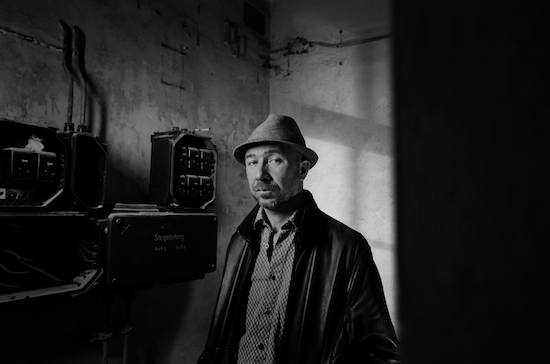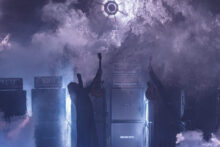The Other Side of Devastation is, to use Star Trek parlance, a temporal anomaly. The debut release from Shackleton’s new moniker The Purge of Tomorrow, the record’s two tracks seem to move forwards and backwards simultaneously. They create a whimsical purgatory, a limbo laden with dazzling patterns. Where the electro-sabar-dubs of Shackleton’s The Majestic Yes, from 2022, conjured ecstatic drums and pace, The Other Side of Devastation is a sideways tapestry of strings, kalimbas and frazzled interference.
Its dwelling on time is pretty unambiguous. It’s there in the project’s name and the album’s title. The release notes claim it’s “not dependent on traditional structures or a linear narrative.” Expecting an album to sit outside temporal progression is a pretty big ask. The fact it’s recorded means it’s got one hand tied behind its back – how non-linear can you be if the start, beginning and end has already been set in mp3 and wax?
The answer perhaps comes in thinking about what non-linear time might look like. A jump out of clock time to make all the machines syncing up our lives moot? A Nietzschean Eternal Return where everything is doomed to come back around? The latter is hinted at in the release notes referring to “feelings of foregone events doomed to be repeated.” But both of these tracks land in a surprisingly hopeful space. There’s a strident energy in this music which feels more Benjaminian than Nietzschean.
In The Arcades Project and ‘Theses On The Philosophy of History’, Walter Benjamin questioned the idea of historical progress, challenging a one-directional view of boundless, irresistible movement through “homogenous, empty time”. Benjamin argued timelines were endlessly complicated and squiggly. He saw the new “permeated with the old” and vice versa, with traces of future utopias hidden in ancient artefacts.
For Benjamin, breaking the predetermined linearity of time held the keys to radical change. Talking about the July 1830 revolution in France, he wrote: “On the first evening of fighting it turned out that the clocks in towers were being fired on simultaneously and independently from several places in Paris.” Agree with Benjamin’s ideas on revolution or not, he provides a framework to think about the way we structure chronology. He didn’t think we could break the space-time continuum or divert the ageing process, but he did think there were possibilities in apprehending different views of our trajectories along time, and time’s trajectory through us. Smoothly delineated orders are only smoothly delineated if you look for smooth delineations.
Blurry chronologies seep through The Other Side of Devastation. On ‘Time Moving’, a frazzle of electronic texture floating around the start seems to prefigure Kathy Alberici’s gorgeous string playing that emerges later, as if we’re hearing the degraded sound before the pristine original. Lattices of rhythm on (what sound like) kalimbas and ideophones wrap around elegiac orchestrations. Whenever it verges on becoming ornate, a glimmer of fried synthesis or a rhythm in a different time frame twists any sense of continuity. Twin voices speak throughout, combining with the music to sound like a mindfulness podcast that’s gone too deep, locking into a perpetual present while the instruments slowly drift along new configurations.
The second track, ‘Waves’, is more amorphous. As if Shackleton and Alberici have started firing at the clocks and left us adrift in the beguiling fallout. Where the first track swings through converging pulses, ‘Waves’ is a spiral. Layers of rhythm and harmony swirl out of each other. Dripping patterns are juxtaposed with washes of echo and shimmer. Not quite capturing the motion suggested by its title, it accumulates layers rather than lapping in ebbs and flows.
Time-bending is a constant in Shackleton’s discography. Even at his most grime adjacent, such as 2004’s Stalker, there’s a sense your mind has been dropped off at a temporal intersection. As his palette has diversified, outlines of different musical traditions emerge, yet they’re seldom directly sampled or appropriated from somewhere specific. Listening is more like pattern recognition, spotting hints of familiar shapes in new configurations. As The Purge of Tomorrow, he ditches the drums and embraces that temporal disorientation even more enthusiastically.
The idea that the extremes of dance and slow evolving, beatless music can affect the listeners’ temporal bearings is a recurring one. A thread running through DeForrest Brown’s 2022 book Assembling a Black Counter Culture situates Detroit techno in a lineage of music that reimagines past, present and future. The connections between William Basinski’s ‘Disintegration Loops’ and ideas of entropy and decay are hardly subtle.
If it works, extremes of polyrhythmic density, minimal monotony and soupy amorphous drift can become a liberatory space, a way of unlatching minds from whichever tick tock or TikTok is currently dictating the experience of the moment. They suggest an altered trajectory through the intervals, whether it’s the time dilation of a dancefloor or the headphone commute drone-out. However, with it being reasonable to say our sense of time is socially and culturally determined, the question that perhaps doesn’t get asked explicitly enough is what exactly is the time this music is allowing us to escape from?
Part of the answer, I’d venture, is a time of obligation, to be productive and living in anticipation of what the future holds. Whether it’s a banging DJ mix or a Kali Malone just-intonation opus, both deploy time gratuitously. While it’s possible (and valid) to speculate on how these extremes can rewire our perceptual matrices, at a more material level they carve out a stretch that doesn’t need to be spent productively. A kind of benevolent attention economy we actively consent to surrendering our time to.
The Other Side of Devastation lands at a moment when everything’s feeling a bit 2008. The unprecedented disruption of a global pandemic has been followed by slightly rebranded austerity, at least in the UK. The cost-of-living crisis has become a metric to chart the passage of time. Price rises at the supermarket have become calendrical – making the past seem blissfully affordable and the future unimaginably pricey. Turning the heating on has become a temporal headache of accumulating debt to pay off at a later date. On the one hand it feels like a cycle of boom and bust is recurring in the day-to-day. On the other the present feels dictated by a straight line towards a future that looks increasingly inhospitable.
The record is distinct in how it plays with the material of time itself. It never fills durations with homogenous, empty sound. Constantly active but never busy, it’s poised on a precipice where layers flow into each other. It shows time’s passing can be mapped as something other than straight lines, circles or stasis. The Purge of Tomorrow’s music might be contained within fixed start and end points, but by filling the space in between with multi-directional activity, it becomes possible to imagine something other than inevitability.





